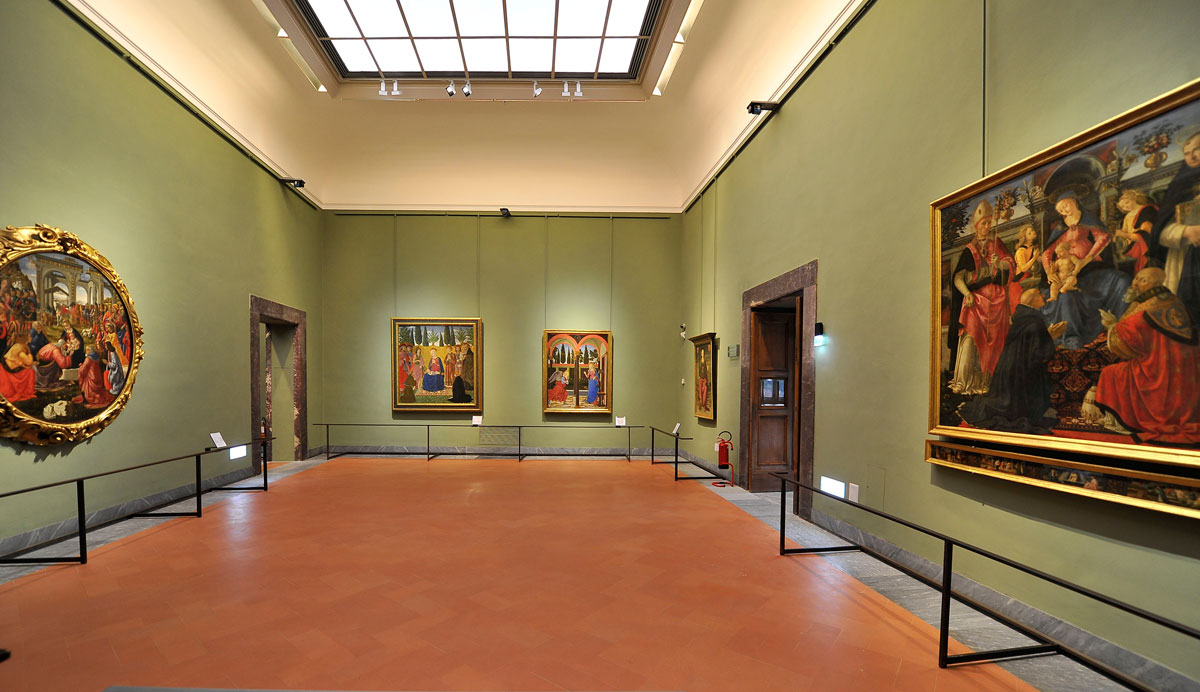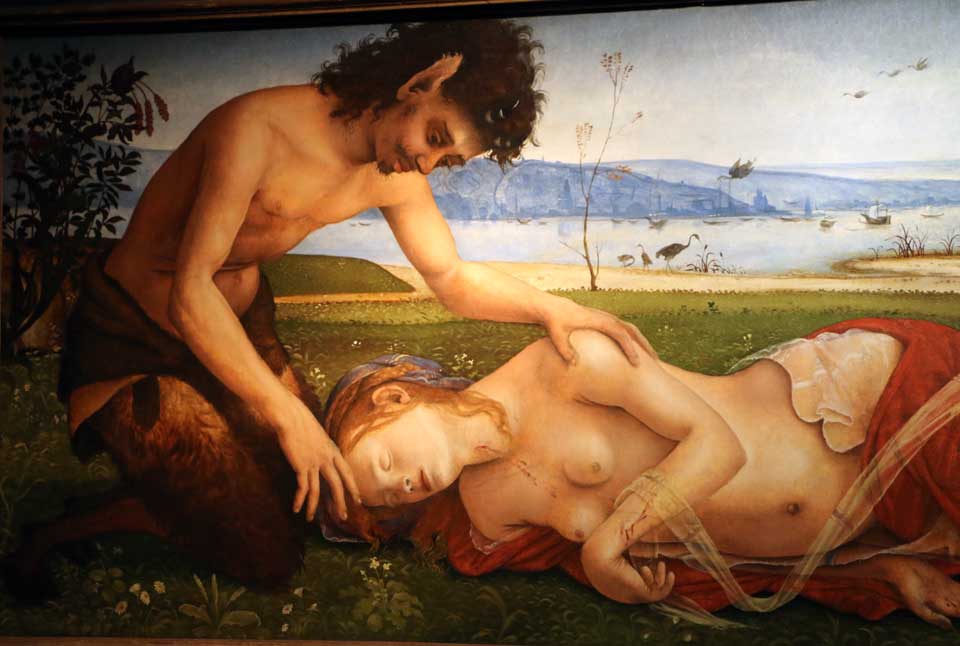
Starting tomorrow, September 22, works by Leonardo da Vinci, Piero della Francesca and Filippo Lippi will temporarily change home. Room 8, with works by Filippo Lippi, will close as the renovation works for the New Uffizi project progress. His most famous works, including the Madonna with Child and Angel (seen above), will temporarily be exposed in the recently reopened Hall 28, which is dedicated to his son, Filippino Lippi. The double portrait of the Dukes of Urbino by Piero della Francesca will find its temporary spot in Hall 22, which houses works by artists from Emilia-Romagna from the 15th century.
Then from Tuesday, October 6, Hall 15 will also close. The room houses Leonardo da Vinci‘s Annunciation and Baptism of Christ, which during the period of renovation will temporarily be in exposition in Hall 79, on the first floor.
Both halls are planned to reopen between Spring-Summer 2016.


After years of renovations, halls 25 through 32 will finally reopen tomorrow, Tuesday September 15th.
The halls were fully renovated with new air, lighting and security systems as well as restored flooring. The rooms are now dedicated to Florentine art from the late 15th century, with 43 works of art (including one sculpture) and contain skylights in the center of the ceilings.
 These rooms held the Medici foundry in the last two decades of the sixteenth century. Before the renovations, the rooms hosted works by 16th century Florentine, Venetian, Emilian and Lombard painters, including the magnificent Tondo Doni by Michelangelo (which is now in Hall 35).
These rooms held the Medici foundry in the last two decades of the sixteenth century. Before the renovations, the rooms hosted works by 16th century Florentine, Venetian, Emilian and Lombard painters, including the magnificent Tondo Doni by Michelangelo (which is now in Hall 35).

A large part of the renovations were possible thanks to a donation of € 600,000 from Salvatore Ferragamo SpA as the renovations are actually not part of the “New Uffizi” project. These rooms had been been restored after the bombing on Via Georgofili 20 years ago.

The new halls now are dedicated as follows:
Hall 25 – Baldovinetti and Ghirlandaio
Hall 26 – Cosimo Rosselli
Hall 27 – Perugino
Hall 38 – Filippino Lippi and Piero di Cosimo
Hall 29 – Lorenzo di Credi
Hall 30 – Doriforo (sculpture)
Hall 31 – Signorelli and Florence
Hall 32 – Signorelli
Then you enter Hall 33 dedicated to Roman art and Hall 34 to the Garden of San Marco (reopened in 2014) before returning to the main corridor.

The new rooms continue the green color found in other recently restored rooms with artwork from the 15th century, starting in Hall 6 (behind the Incoronation of Lorenzo Monaco) and in hall 7 (behind the Adoration of the Magi by Gentile da Fabriano) and continued in the Mantegna and Bellini hall (hall 20).

As paintings that were once housed in these rooms have made their way into other halls, the chance presented itself to take 25 works of art from the Uffizi deposits and make them part of the permanent collection, reorganizing the halls to also better present and value works of art that are often overshadowed by others in the great halls of the Uffizi Gallery. Such is the case for Ghirlandaio’s “Adoration of the Magi” that now takes over the entire wall where Michelangelo’s Tondo Doni used to be and Halls 26 and 29 whose works all come from the deposits from great artists of the late 15th century that have up to now not been highlighted at the museum, often just for lack of space.
Finally – enjoy the view over the rooftop of the Uffizi with view of the Duomo and Palazzo Vecchio from Hall 31!


German art historian, Eike Schmidt, currently at the Minneapolis Institute of Art, has just been appointed as the new director of the Uffizi Gallery.
The announcement arrived yesterday from the Minister of Culture and Tourism in Italy, Dario Franceschini, as the international competition drew to a close with the selection of 20 new directors to some of Italy’s top museums. Four out of the 13 Italians selected will return to Italy after experiences abroad, while 10 out of the 20 directors are female.
Schmidt is one of 7 foreigners selected to head top museums across Italy, including the Accademia Gallery in Florence where another German, Cicilie Hollberg, will take over, the Capodimonte Museum in Naples and the Brera Gallery in Milan (to be headed by James Bradburne who up to a few months ago was director at Palazzo Strozzi in Florence).
This is the first time a foreigner will run the Uffizi Gallery. Mr Schmidt replaces the well-respected Antonio Natali, who has been director of the Uffizi since 2006 and who was one of 10 short-listed for the position.
The new directors are part of a national reform to grant more autonomy to top museums in Italy which are overseen by the Italian Culture Ministry.
Schmidt, 47 years old, and born in Freiburg im Breisgau, studied Medieval and Modern Art History in Heidelberg, where he also completed a doctorate with a thesis on “The Medici Ivory Sculpture Collection in the 16th and 17th Centuries”. Since 2009, he has been at the Minneapolis Institute of Arts as curator and director of the Sculpture, Applied and Textile Arts Department. From 1994 to 2001, he worked as a researcher at Florence’s Deutsches Kunstshistorisches Institut. Between 2001 and 2006, he was curator and researcher at Washington D.C.’s National Gallery of Art, from 2006 to 2008 curator of the Sculpture and Decorative Arts Department at the J. Paul Getty Museum in Los Angeles. Between 2008 and 2009, he worked at Sotheby’s in London as director and head of the European Sculpture and Applied Arts Department. Considered an international expert on Florentine art, he has authored numerous monographs and essays.
The date for his tenure to start has not been officially communicated.
Photo credit © Dan Dennehy

Starting tomorrow, July 14th, visitors to the Uffizi Gallery will find Hall 9 dedicated to the Pollaiolo brothers, Antonio and Piero, and to Sandro Botticelli, in the Uffizi Gallery will be closed to the public.
The Renaissance master’s most famous works have been temporarily moved to the large
Hall 41, accessed from the Third Corridor, which used to house Rubens’s monumental
canvases. The room has been restored and upgraded to current museum standards thanks
to a generous donation from the non-profit foundation Friends of Florence. The
foundation’s major contribution is also making it possible to dismantle and refurbish the
Botticelli Room (10-14) that is scheduled to reopen in 2016.

Antonio Natali, director of the Uffizi, said “Botticelli’s masterpieces are the most widely viewed paintings in the entire collection, and so, in order not to deprive visitors of the opportunity to see them, we worked night and day here in the Uffizi to set up another room to host them during the remodeling work. Ultimately, I believe that their new home will offer an even more vibrant view of Botticelli’s paintings”.

The closing will make it possible to proceed with the “Nuovi Uffizi” – New Uffizi – project which, in addition to indispensable system renovations, will involve a new arrangement of the rooms and a striking display of Botticelli’s paintings.

THE TEMPORARY SETTING
Room 41 will temporarily host a carefully selected group of paintings by Sandro Botticelli. The Madonna of the Magnificat and The Madonna of the Pomegranate will be on the entrance wall; The Adoration of the Magi, The Primavera (Allegory of Spring), and The Calumny of Apelles will be on one of the side walls, and The Madonna and Child with Saints , The Birth of Venus and Pallas and the Centaur will be on the other. On the wall facing the entrance, the Portrait of a Man with a Medal of Cosimo the Elder and Judith and Holofernes will flank the monumental Portinari Triptych by Hugo van der Goes which will be the fulcrum of a section entirely dedicated to fifteenth-century Northern European paintings when the reorganization of the museum is completed.
The new rooms highlight aspects of the paintings which could not be fully appreciated up until now with the the new lighting and added space in between. Visitors who have previously visited the museum will be able to view Botticelli’s masterpieces in a new light, literally speaking.

Works from the Pollaiolo brothers will be divided – some have gone into Hall 8 while others have been moved to the ground floor, to San Pier Scheraggio, which is usually closed but will be open for guided visits on Thursdays and Saturdays throughout the summer for free.
You can view the moving of Botticelli’s main works which occurred last night in the museum to the new hall in the video below and a preview of what Hall 41 looks like!

Thanks to the Amici degli Uffizi who funded the project, the entire two top floors that constitute the museum’s main halls now offers visitors access to free Wi-Fi. Visitors will be able to check email and visit select websites from their own smart phones or tablets, but the main reason for the new network is to give these users the possibility to access the new webAPP Visitor’s Guide to the Uffizi Gallery while you’re inside the museum.
The new network has been active since July 7th, 2015 and allows up to 500 connected users at any time. This transforms the Uffizi Gallery into the first museum in Italy to offer visitors this step to today’s modern world where most everyone travels with a technological gadget to keep updated.
The network brings the 430 year old museum into the present, but looks toward the future. By being connected, the museum can plan future exhibits and displays with the use of high-definition video, 3D reconstructions, virtual reality and augmented reality.
At the same time, visitors will have access to the new Visitors Guide (as soon as you open a browser you will be directed to this site), where you can find all of the information you need to make the best use of your time and your visit to the museum. News, information on current exhibits within the Uffizi, maps and itineraries as well as detailed information on the works of art in each of the halls you visit. It also has a section that outlines the New Uffizi Project which is modernizing the museum while keeping it open to the world. The guide at the moment is in English and Italian, with more languages to be added soon.
For now, this is available to those who enter the museum with their own phones and tablets, but the museum is looking forward to being able to offer the rental of these devices for those who need them.
We hope you’ll soon be enjoying your visit to the Uffizi Gallery even more!

Visitors coming to visit the Uffizi Gallery over this next week will be seeing several “works in progress” as the museum prepares to close down the Botticelli Rooms (Halls 10-14) for renovation as part of the New Uffizi project.
From July 14th, 2015 Halls 10-14 will be CLOSED, with planned reopening in the Spring of 2016. Some of the smaller paintings housed in these rooms have already been removed between the night of July 5th and Monday, July 6th, during the museum’s closed hours. Throughout the week, some of the smaller paintings will make their way to Hall 41 which will house the most famous Botticelli paintings while restoration of the rooms is underway.
Hall 41 itself has been restored and prepared for the move to house, among others, Botticelli’s Spring and Birth of Venus, thanks to support from Friends of Florence, a non-profit organization.
Hall 41 will house a select number of works, which will include Botticelli’s:
– Adoration of the Magi
– Calumny
– Madonna with Child and Saints
– Madonna of the Magnificat
– Madonna of the Pomegranate
– Pallas and the Centaur
– Birth of Venus
– Spring (Allegory of Spring)
– Portrait of Man with Medallion
– Stories of Judith
Within the same room, Hugo van der Goes’s Portinari Tryptych will also be on display in this room. Within the museum’s new exposition, this hall will eventually host 15th century paintings from Northern Europe.

With summer here, the Uffizi Gallery once again announces longer opening hours and special openings. These are the details:
SATURDAYS
Starting June 27th and through December 19th, the Uffizi Gallery will have longer opening hours every Saturday. The museum will remain open until 11pm. Ticket office will close at 10:05pm. There will be no longer opening hours on December 12th.
TUESDAYS
Starting July 7th until September 29th, the Uffizi Gallery will also remain open every Tuesday until 10pm. Last entrance you can book online is at 8pm.
Take advantage of the longer opening hours to go visit the Uffizi in the late afternoon, early evening when the crowds are generally reduced!
Take your time to enjoy the latest current temporary exhibition, too!

The Contini Bonacossi Collection at the Uffizi Gallery is not normally open for visits.
Take advantage right now that the museum is offering free guided visits from now until June 3.
Visits are offered only on Wednesday afternoons at 2:30pm and at 4:15pm.
Groups will be up to a maximum of 15 visitors – you need to reserve your spot by calling 055-2388693 from Tuesday and Saturday between 2:30 and 4:30pm.
Meeting point is under the Loggiato of the Uffizi at Gate 1 (prebooked tickets) 20 minutes before the start of the visit. Visitors will have to go through the metal detectors, then will be accompanied up the stairs to enter into the Collection directly. A visit to the rest of the Uffizi Gallery is not included.
UPDATE May 12: Two more visits have been added on Wednesday mornings given request, at 9am and 11am. The collection will remain open until June 3.

This year, the Uffizi Gallery will NOT have a special opening on the evening of April 30th as part of the city’s “White Night” program nor will it be open on May 1st. There was no agreement between the employee unions to have enough staff to open the museum for the times that were necessary for the museum to be open. The museum will remain open on April 30th until normal closing times, which is 18.50.
If you’re in Florence on April 30th and May 1, take a look at this post which has a list of museums that will be open for the White Night and on May 1st.
The museum is open on May 2nd and 3rd; on May 3rd entrance will be free for everyone as part of Italy’s “First Sunday of the Month” cultural initiative offering free entrance to all State museums.

Yesterday, halls 2 – 7 which house 13th to 14th century Italian works of art reopened after 9 months of renovation works. The work that was carried out in these 6 rooms has been extraordinary, including the fact that the 3 “majesties” housed in hall 2 by Giotto, Cimabue and Duccio da Buoninsegna and Monaco’s Incoronation remained in the halls (due to their massive size) but with a special protective box especially constructed around them this entire time.

During these months of intense labor as the New Uffizi project proceeds, the halls received new lighting, both natural and artificial, and new air systems. The artworks have been better distributed to allow for a better reading and enjoyment of the works. With the reopening of Hall 1 last year, several works from Hall 2 had been moved to that new hall and this allowed the integration of a total of 14 “new” works in these rooms, coming from other Florentine museums and from the Uffizi’s own deposits. This includes the marvelous Madonna of Humility by Nicola di Guardiagrele at the top of this post, the only work known by this artist.

The new hall 6 dedicated to Lorenzo di Monaco.
Chief among the new elements visitors will find in the new rooms is that Hall 6 which was devoted to International Gothic art has now been divided into two rooms, Hall 6 now being devoted entirely to Lorenzo Monaco and Hall 7 now hosting Gentile da Fabriano and International Gothic where you can enjoy Gentile’s Adoration of the Magi set against a green background, the color chosen to represent the 15th century.

The new hall 7 dedicated to Gentile da Fabriano.
The information on all of the new halls will soon be updated, in the meantime we hope visitors will enjoy the new rooms and the chance to admire some of the greatest works of art from the 13th-14th centuries.









